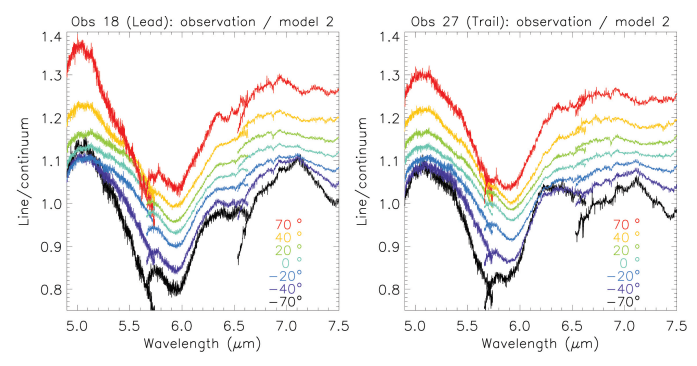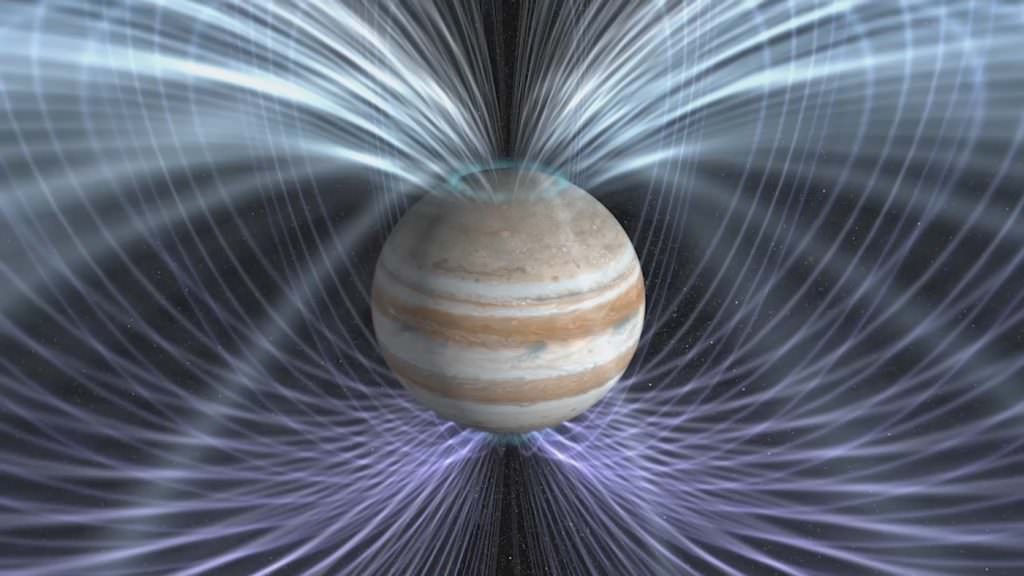Nature doesn’t conform to our ideas of neatly-contained categories. Many things in nature blur the lines we try to draw around them. That’s true of Jupiter’s moon Ganymede, the largest moon in the Solar System.
The JWST took a closer look at Ganymede, the moon that’s kind of like a planet, to understand its surface better.
Ganymede is basically a planet, except it doesn’t orbit the Sun. If it did orbit the Sun instead of Jupiter, it would be indistinguishable from a planet. It has a differentiated internal structure with a molten core that produces a magnetic field. It has a silicon mantle much like Earth’s, and has a complex icy crust with a deep ocean submerged beneath it. It has an atmosphere, though it’s thin. It’s also larger than Mercury, and almost as large as Mars. According to the authors of a new study, it’s an archetype of a water world.
But even with all this knowledge of the huge moon, there are details yet to be revealed. This is especially true of its complex surface. “Following previous observations, there remain several open questions on the nature, the origin and the processes making up Ganymede’s current surface composition,” the authors of a new paper write. The JWST has the observing power to uncover answers to some of these questions. What did it find?
A team of researchers from the US, Europe, and Japan examined Ganymede’s surface with the JWST’s NIRSpec and MIRI instruments. Their results are in a paper titled “Composition and thermal properties of Ganymede’s surface from JWST/NIRSpec and MIRI observations.” It’ll be published in the journal Astronomy and Astrophysics, and the lead author is French planetary scientists D. Bockelee-Morvan from LESIA – Observatoire de Paris.
Ganymede’s surface is dominated by two types of terrain: bright, icy terrains with grooves, and darker regions. The bright regions cover about two thirds of the surface, and the dark regions cover the rest. Both types are ancient, but the darker regions are older, and also highly cratered. The two types are intermingled, with the lighter terrain cutting swathes across the darker terrain.

The Galileo and Juno missions examined Ganymede’s surface chemistry, as have ground telescopes. But there are still outstanding questions. “Following previous observations, there remain several open questions on the nature, the origin and the processes making up Ganymede’s current surface composition,” the authors write.
There’s ample CO2 on Ganymede, but it seems to be trapped in other molecules. That’s the type of arrangement that attracts the attention of scientists. Mapping the CO2 will help explain what these other molecules are and how the situation developed.
There’s water ice on Ganymede, but it appears to be amorphous ice. The JWST mapped the distribution and properties of the ice. There’s also a newly-detected absorption band on Ganymede at 5.9-µm and the JWST can help determine its origins.

Ganymede’s temperature range means that pure CO2 ice is not expected on the moon’s surface. JWST observations show that some of the CO2 is trapped in water ice, though only about 1% by mass. The rest is trapped in different minerals and salts.
When it comes to water ice, the JWST found that there’s more of it directly exposed at the polar regions. These regions are where energetic ions from Jupiter irradiate Ganymede’s surface. The authors write that it can be explained by “… the combination of micro-meteoroid gardening, excavating the ice, and ion irradiation.” That’s followed by water-vapour re-accreting on top of non-ice materials, forming purer water ice which the JWST easily detected.
Observations showed that the absorption band at 5.9-µm is widespread on Ganymede, but with local variations. The researchers recognize the possibility that this is from insoluble organic material delivered by carbonaceous chondrites or comets, but ultimately excluded that explanation. “Sulfuric acid hydrates H2SO4 + H2O appear to be good candidates to explain the 5.9-µm band,” the authors write.
These are detailed results that tell scientists a lot, but the rest of us not so much. But other findings are more easily grasped. For example, some of the overall differences between Ganymede’s poles and the leading and trailing edges. “The spectral properties of the polar regions are very different for leading vs. trailing sides,” they write. “The origins of these differences remain to be investigated.” Some of this is because of Jupiter’s powerful effect on its moons.

The relationship between Jupiter and Ganymede is kind of like the relationship between the Sun and Earth. The Sun’s solar wind strikes Earth’s magnetosphere in the same way that Jupiter’s plasma strikes Ganymede’s trailing side. Not only that, but Ganymede’s magnetic field interacts with Jupiter’s, helping to create Jovian aurorae.
Ganymede and Jupiter are in a complicated relationship, and some of that relationship extends to Ganymede’s surface chemistry, where Jupiter’s plasma strikes the moon’s poles and irradiates the ice. While this research has advanced our understanding of that and other aspects, it doesn’t give us the kind of slam-dunk answers we hunger for. But that’s science; it’s not all glory and headlines.
Ganymede is a fascinating moon that’s almost a planet. We know that it probably formed from left-over material in Jupiter’s sub-nebula, but that was billions of years ago. A lot has happened since, and it’s led to the compelling world we see now, with a warm, potentially life-supporting ocean larger than all of Earth’s oceans combined. These JWST observations are the most detailed yet, but according to the authors, we aren’t quite equipped to interpret them completely. When we do, there will likely be some more surprises.
“From an observational perspective, this JWST investigation has shown that observations designed to investigate diurnal variations of Ganymede’s surface properties may unravel unexpected processes,” the authors write. And as is often the case, the results will inform and shape our next attempt to understand this fascinating world.
“Altogether the results obtained in this study will certainly help in optimizing the observation strategies of the Moons And Jupiter Imaging Spectrometer (MAJIS) onboard the ESA/JUICE mission which will explore Ganymede further.”
But we’ll have to wait. The ESA’s JUICE mission launched last Spring, and will reach Jupiter in the Summer of 2031. Prepare for more surprises from this planet-like moon.
The post JWST Takes a Detailed Look at Jupiter’s Moon Ganymede appeared first on Universe Today.
from Universe Today https://ift.tt/nHcZ3SG
via IFTTT
Comments
Post a Comment